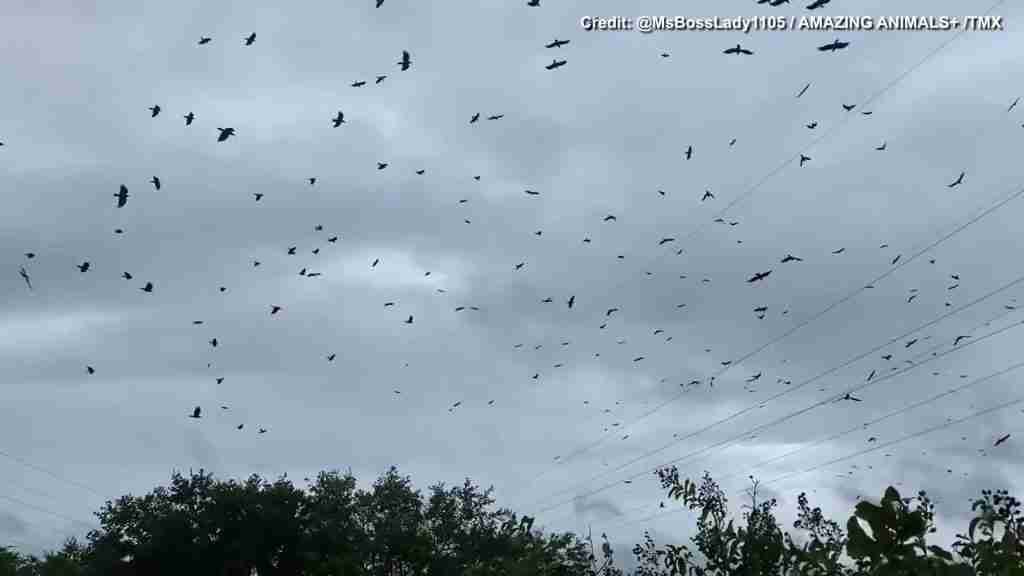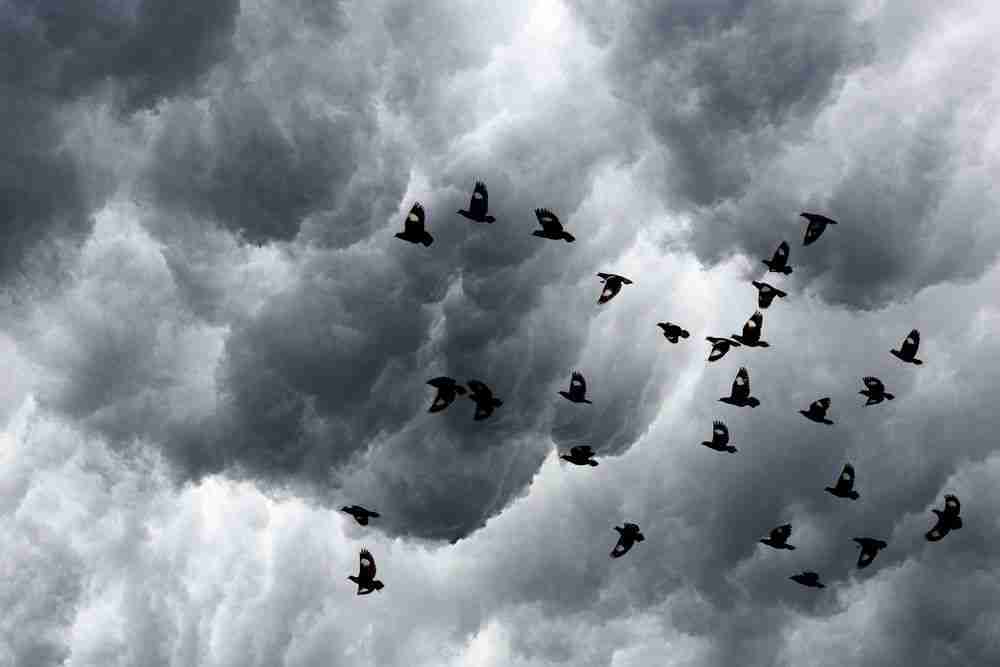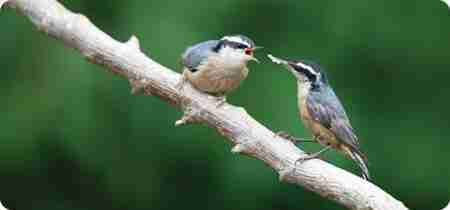Imagine a world where the wind is fierce, the rain is relentless, and chaos reigns supreme. In the midst of this turmoil, birds navigate the storm with remarkable grace and resilience. Ever wondered how birds respond during a hurricane? With Hurricane Idalia approaching, their instinctual behaviors come to life in a fascinating dance of survival. From seeking shelter to altering their flight patterns, these magnificent creatures prove time and time again that the resilience of nature knows no bounds. Join us as we explore the incredible ways in which birds adapt and respond during the tumultuous events of a hurricane.
Bird Behavior Before a Hurricane
Migration to Safer Areas
Before a hurricane strikes, birds have an incredible ability to sense the impending danger and instinctively migrate to safer areas. Birds possess an innate ability to detect changes in atmospheric pressure, temperature, and wind patterns, allowing them to anticipate the arrival of a hurricane. By flying to more secure locations, such as areas with lower wind speeds or areas outside the hurricane’s path, birds are able to increase their chances of survival.
Gathering in Large Flocks
Another notable behavior exhibited by birds before a hurricane is their tendency to gather in large flocks. This behavior serves multiple purposes. Firstly, by congregating in large groups, birds are able to enhance their chances of survival through collective defense against predators. Additionally, being in a flock provides opportunities for birds to learn from each other and exchange valuable information about food sources and potential threats. This collective behavior also helps birds create a sense of security and protection in the face of an approaching hurricane.
Increased Feeding Activity
In the days leading up to a hurricane, birds exhibit a noticeable increase in their feeding activity. This behavior is driven by the birds’ need to stock up on energy reserves to sustain them during the storm. They actively forage for food, consuming large quantities of insects, fruits, seeds, and other available food sources. By maximizing their food intake, birds ensure they have enough energy to endure the challenges they will face during the hurricane.
Bird Behavior During a Hurricane
Taking Shelter
During a hurricane, birds actively seek shelter to protect themselves from the strong winds and heavy rain. They utilize a variety of shelters, such as dense vegetation, crevices in trees, cliffs, or even human-made structures. Seeking shelter allows birds to reduce their exposure to the harsh weather conditions, increasing their chances of survival.
Reduced Mobility
As hurricanes unleash their fury upon the land, birds experience a significant reduction in their mobility. The strong winds make it difficult for birds to maintain stable flight or move around freely. Consequently, many birds hunker down in their chosen shelters and remain relatively still, waiting for the storm to pass. This reduced mobility is a survival strategy to conserve energy and minimize the risk of being blown away or injured by flying debris.
Clinging to Secure Structures
To withstand the intense winds of a hurricane, birds often cling tightly to secure structures. This behavior is observed in cases where birds choose to seek refuge in man-made structures like buildings or bridges. Birds will brace themselves against the wind by gripping onto the structures using their strong feet and claws. By tightly gripping these structures, they are better able to ride out the storm and avoid being swept away.

This image is property of www.wfla.com.
Bird Behavior After a Hurricane
Returning to the Area
Once the hurricane has passed and the skies clear, birds exhibit a remarkable ability to return to the affected areas. Through their innate navigational skills and memory of familiar landscapes, birds find their way back to the habitats they once inhabited. Their return is a testament to their resilience and adaptability.
Reestablishing Territory
After a hurricane, birds engage in territorial behaviors to reclaim their former territories. They protect their nesting sites, feeding areas, and preferred habitats from other birds. This territorial behavior is crucial for their survival and ensures they have adequate resources to rebuild their lives after the devastation of the storm.
Rebuilding Nests
Birds face the challenging task of rebuilding their nests after a hurricane. Nest destruction is a common consequence of the strong winds and heavy rains associated with hurricanes. However, birds display a remarkable resilience and determination as they work diligently to reconstruct their nests. They collect new nesting materials, often using debris from the hurricane, and rebuild their homes from scratch. This process can be time-consuming and resource-intensive for the birds, but it is essential for their breeding success and population recovery.
Impact of Hurricane Idalia on Birds
Disruption of Migratory Patterns
The arrival of Hurricane Idalia can have a profound impact on bird populations, particularly those engaged in migration. The hurricane’s strong winds and altered weather patterns can disrupt the birds’ migratory routes and cause them to deviate from their intended paths. This disruption can result in a delay in reaching their designated wintering or breeding grounds, affecting their ability to find food, secure shelter, and successfully reproduce.
Mortality Rate
Unfortunately, hurricanes often exact a heavy toll on bird populations. The strong winds, heavy rains, and flying debris associated with these storms can lead to increased mortality rates among birds. They may become disoriented, unable to find suitable shelters, or even be directly impacted by falling trees or collapsing structures. The mortality rate among birds during and immediately after a hurricane can be significant, particularly for those that are unable to escape the path of the storm.
Habitat Destruction
One of the most devastating consequences of hurricanes for bird populations is the destruction of their habitats. Hurricanes can uproot trees, destroy vegetation, and flood entire coastal areas, drastically altering the landscape that birds rely on for their survival. This destruction can lead to a loss of nesting sites, reduced food availability, and a decrease in suitable habitats for breeding and foraging. The long-term impact of habitat destruction caused by Hurricane Idalia can have far-reaching consequences for bird populations and the ecosystems they inhabit.

This image is property of www.treehugger.com.
The Resilience of Bird Species
Adaptive Strategies
Birds are known for their remarkable adaptive strategies, which enable them to survive and recover from the impacts of hurricanes. Their ability to migrate, gather in flocks, and adjust their behaviors in response to changing conditions highlights their resilience in the face of adversity. These adaptive strategies have been shaped by millions of years of evolution, allowing bird species to endure and persist in the most challenging environments.
Survival Techniques
To increase their chances of survival during a hurricane, birds employ various techniques. These techniques include taking shelter, reducing mobility, and clinging to secure structures, which we discussed earlier. By employing these survival techniques, birds minimize their exposure to risks and optimize their chances of riding out the storm. Their instincts and behaviors honed over generations are instrumental in their ability to weather the storm and emerge resilient.
Species Diversity
The diversity of bird species plays a crucial role in their overall resilience. Different species have distinct ecological requirements, behaviors, and adaptations that allow them to survive under varying conditions. This diversity ensures that, even in the aftermath of a hurricane, there are likely to be some bird species that are better equipped to cope with the changed environment. The presence of different species also helps maintain ecological balance and enhances the overall resilience of bird populations.
Case Study: Bird Response During Hurricane Idalia
Observations from Ornithologists
Ornithologists have conducted extensive research to understand how bird populations respond during hurricanes, and Hurricane Idalia serves as an important case study. These researchers have documented and analyzed bird behavior before, during, and after the hurricane, providing valuable insights into the impact of severe storms on avian populations.
Species-Specific Reactions
During Hurricane Idalia, different bird species exhibited unique reactions to the storm. Some species displayed strong migratory tendencies, flying long distances to safer areas before the hurricane hit. Others flocked together in large groups, finding strength in numbers as they faced the onslaught of high winds. The observations made by ornithologists during this hurricane have shed light on the diverse strategies birds employ to increase their chances of survival.
Long-term Consequences
The long-term consequences of Hurricane Idalia on bird populations are still being studied by researchers. The impact on migratory patterns, nesting success, and population dynamics will require ongoing monitoring and analysis to fully understand. By studying the aftermath of Hurricane Idalia, scientists can gain valuable insights into the recovery processes of bird species and identify potential measures for mitigating the negative effects of future hurricanes.

This image is property of www.siouxlandproud.com.
Importance of Understanding Bird Behavior During Hurricanes
Conservation Efforts
Understanding bird behavior during hurricanes is crucial for effective conservation efforts. By comprehending how birds respond to storms, conservationists can identify key habitats to protect, implement appropriate management practices, and establish conservation areas that prioritize the needs of both resident and migratory bird species. Protecting and preserving these habitats is essential for maintaining healthy bird populations and the overall biodiversity of ecosystems.
Impact on Ecosystems
Birds play a vital role in maintaining the balance and functioning of ecosystems. Their interactions with plants, insects, and other animals contribute to various ecological processes such as pollination, seed dispersal, and pest control. By understanding the behavior of birds during hurricanes, researchers can better assess the impact of these storms on ecosystem dynamics and identify potential cascading effects that may occur as a result of bird population changes.
Forecasting Weather Patterns
Studying bird behavior during hurricanes also contributes to our understanding of weather patterns. Birds’ ability to detect and respond to changes in atmospheric conditions can provide invaluable insights into the development and behavior of hurricanes. By monitoring bird reactions and movements, scientists can potentially improve the accuracy and reliability of hurricane forecasting models, helping communities better prepare for these powerful storms.
Role of Citizens in Supporting Bird Conservation
Providing Bird-friendly Habitats
Citizens can play a pivotal role in supporting bird conservation efforts, particularly in regions susceptible to hurricanes. Creating bird-friendly habitats in our own backyards, gardens, and public spaces can provide essential refuge for birds during and after a hurricane. Planting native vegetation, providing bird feeders and birdhouses, and minimizing the use of pesticides all contribute to creating a welcoming environment for our feathered friends.
Reporting Bird Sightings
Citizens’ contributions to bird conservation extend beyond the physical realm. Reporting bird sightings, especially during hurricanes or in the immediate aftermath, can provide valuable data to ornithologists and researchers. These observations help monitor the movement and behavior of bird populations, track changes in distribution patterns, and assess the impact of hurricanes on specific species. Citizen scientists can make a tangible impact on our understanding of birds’ response to hurricanes by sharing their unique observations.
Supporting Research Efforts
Supporting research efforts through volunteering or contributing to organizations focused on bird conservation is another way citizens can make a meaningful difference. Many research projects rely on the participation and support of individuals passionate about birds and their conservation. By donating time, resources, or funds to these initiatives, citizens play an active role in advancing our knowledge and understanding of how birds respond to hurricanes and their subsequent recovery processes.

This image is property of static01.nyt.com.
Future Research Directions
Effect of Climate Change on Bird Behavior
As climate change continues to alter weather patterns, it is imperative to investigate how bird behavior during hurricanes may evolve. Research focusing on the impact of climate change on bird migration patterns, alterations in storm intensity and frequency, and shifts in habitat availability will help guide conservation efforts and identify strategies to support bird populations in an increasingly changing world.
Improved Tracking Methods
Advancements in tracking technology provide exciting opportunities for future research on bird behavior during hurricanes. Integrating lightweight GPS or geolocators into bird tagging and tracking methodologies can enable more precise monitoring of bird movements, migration patterns, and responses to hurricanes. These technological advancements can unlock new insights into the behavioral dynamics of birds during severe storms.
Effects on Breeding Patterns
Understanding how hurricanes impact bird breeding patterns is an area that warrants further investigation. Hurricanes can disrupt breeding cycles, nesting success, and the overall reproductive output of bird populations. Research focusing on the influence of hurricanes on courtship, mating behavior, nest site selection, and chick-rearing processes will contribute to our knowledge of how these storms shape bird reproduction and potentially inform strategies for conservation and management.
Conclusion
Bird behavior during hurricanes is a fascinating topic that exemplifies the resilience and adaptability of these remarkable creatures. Before a hurricane strikes, birds migrate to safer areas, gather in large flocks, and increase feeding activity. During a hurricane, birds take shelter, reduce mobility, and cling to secure structures. After a hurricane, they return to the area, reestablish territory, and rebuild nests. However, hurricanes like Idalia can disrupt migratory patterns, increase mortality rates, and cause habitat destruction. Understanding bird behavior is crucial for conservation efforts, ecosystem stability, and forecasting weather patterns. Citizens can contribute by providing bird-friendly habitats, reporting sightings, and supporting research efforts. Future research should explore the effects of climate change, improve tracking methods, and assess the impact on breeding patterns. By studying bird behavior during hurricanes, we deepen our understanding of these incredible creatures and strengthen our ability to protect and conserve them in the face of adversity.




